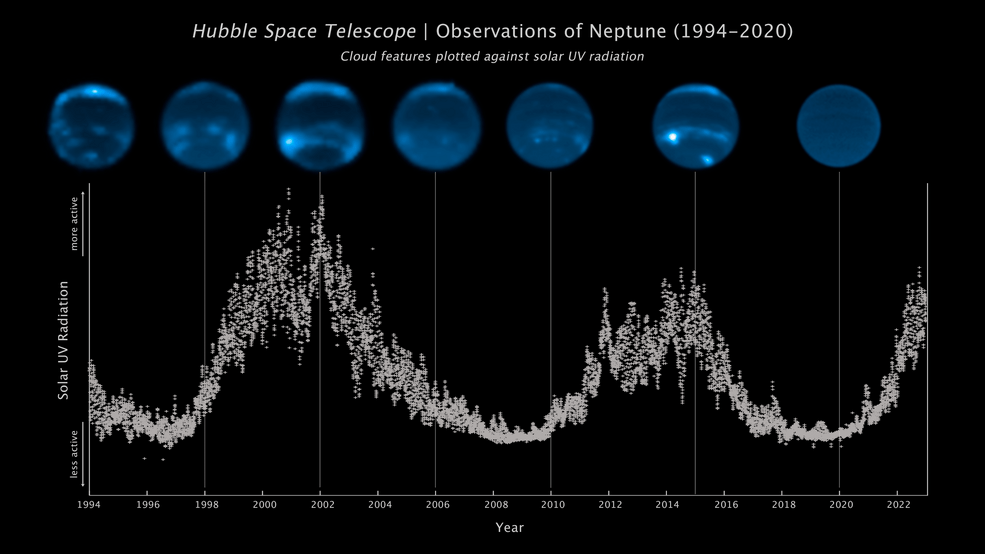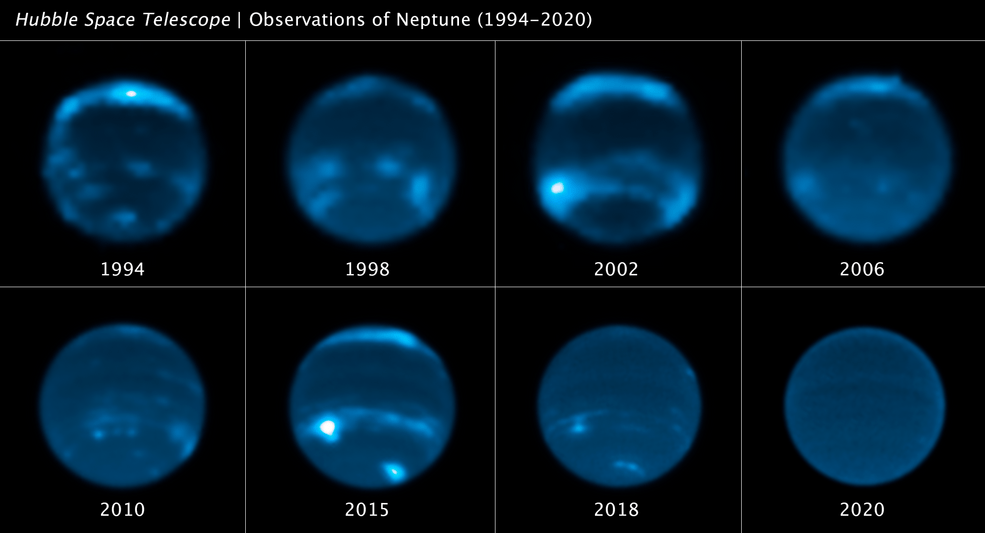Whenever Neptune reaches its closest point in the sky to Earth, its portrait is taken by the Hubble Space Telescope and other ground-based observatories. Watching the planet from 1994 to 2020, astronomers have made puzzling discovery.
The clouds in Neptune’s atmosphere appear to be to be linked to the solar cycle and not the planet’s cycle of seasons. The global cloud cover seems to come and go in a cycle that apparently syncs up with the Sun’s 11-year cycle, as it shifts from solar maximum to solar minimum or vice versa. This is surprising since Neptune is so far from the Sun and receives about 0.1% of Earth’s sunlight.
This discovery is based on three decades of Neptune observations captured by the Hubble Space Telescope, the Keck Observatory in Hawaii, and the Lick Observatory in California.
“These remarkable data give us the strongest evidence yet that Neptune’s cloud cover correlates with the Sun’s cycle,” said Imke de Pater, emeritus professor of astronomy at UC Berkeley and senior author of the study, in a NASA press release. “Our findings support the theory that the Sun’s UV rays, when strong enough, may be triggering a photochemical reaction that produces Neptune’s clouds.”
Each of Neptune’s four seasons last approximately 40 years during the planet’s 165-year orbit around the Sun.
Currently, the cloud coverage on Neptune is extremely low, while just five years ago there was an abundance of clouds. The astronomers making the observations noted that the abundance of clouds normally seen at the icy giant’s mid-latitudes started to fade in 2019.
“I was surprised by how quickly clouds disappeared on Neptune,” de Pater said. “We essentially saw cloud activity drop within a few months.”
“Even now, four years later, the most recent images we took this past June still show the clouds haven’t returned to their former levels,” said Erandi Chavez, a graduate student at the Center for Astrophysics | Harvard-Smithsonian (CfA) in Cambridge, Massachusetts, who led the study when she was an undergraduate astronomy student at UC Berkeley. “This is extremely exciting and unexpected, especially since Neptune’s previous period of low cloud activity was not nearly as dramatic and prolonged.”
Chavez and her team analyzed Keck Observatory images taken from 2002 to 2022, Hubble Space Telescope archival observations beginning in 1994, and data from the Lick Observatory in California from 2018 to 2019.

The nearly-30-year-long set of observations shows that the number of clouds grows increasingly following a peak in the solar cycle – where the Sun’s level of activity rhythmically rises and falls over an approximately 11-year period. This graph, above, shows images from the Hubble Space Telescope, and the Sun’s level of ultraviolet radiation is plotted in the vertical axis. The 11-year cycle is plotted along the bottom from 1994 to 2022. The Hubble observations clearly show a correlation between cloud abundance and solar peak of activity.
During the periods of intense solar activity – which includes an increasing number of sunspots and more solar flares — more intense ultraviolet (UV) radiation floods the solar system. The team found a positive correlation between the number of clouds and the ice giant’s brightness from the sunlight reflecting off it.
In their paper, published in Icarus, the team proposed that the chemical changes are caused by photochemistry which happens high in Neptune’s upper atmosphere.
“The clear positive correlation we find between cloud activity and Solar Lyman-Alpha irradiance lends support to the theory that the periodicity in Neptune’s cloud activity results from photochemical cloud/haze production triggered by Solar ultraviolet emissions,” the team wrote.
There appears to be a two-year delay in when clouds increase as the photochemistry takes time to form clouds.
But there are still open questions on these observations. For example, while an increase in UV sunlight could produce more clouds and haze, it could also darken them, thereby reducing Neptune’s overall brightness. There are also other storms on Neptune rising up from the deep atmosphere that could affect the cloud cover, but are not related to photochemically produced clouds. This may complicate correlation studies with the solar cycle.
The team said they will continue to track Neptune’s cloud activity to see how long the current near-absence of clouds will last. They have taken advantage of the James Webb Space Telescope’s observations of the planet, but are still analyzing the JWST data.
“We have seen more clouds in the most recent Keck images that were taken during the same time NASA’s James Webb Space Telescope observed the planet; these clouds were in particular seen at northern latitudes and at high altitudes, as expected from the observed increase in the solar UV flux over the past approximately 2 years,” said de Pater.

